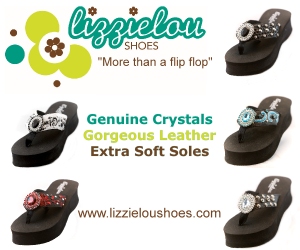This guest post is written by Sheena G. Edwards, founder of Lizzie Lou Shoes and one of the women featured in Mom Incorporated: A Guide to Business + Baby.
Through hard work and perseverance, Sheena has made Lizzie Lou Shoes a successful company. But it hasn’t been easy. As she says in the book, “This is a labor of love. If I didn’t walk into my closet and see 20 pairs of flip-flops I loved, I would have quit. Because at 10 at night, I’m tired and sometimes you have to keep going. If you don’t love it, you won’t keep going.
Here’s what Sheena has to say about mistakes she made early-on, and how she managed to overcome them.
By Sheena G. Edwards
I started my imported flip-flop business, Lizzie Lou Shoes, http://www.lizzieloushoes.com/ in the summer of 2008 with not much more than a dream and a great contact.
Six months of designing, sampling, re-designing, working to find the right manufacturer, identifying potential retail dealers, and learning the ins and outs of customs law led to the arrival of the first prototypes. They looked great — everything about them was beautiful. I couldn’t believe my idea was now real. I told my agent and co-designer in India to go forward and start manufacturing a huge first order of shoes.
The shipment arrived on April 20, 2009, each pair in its own shoe box ready to sell. There was so much excitement as my family and I looked at the huge pallet of boxes stacked in the garage. But it gave way to disappointment as we opened the boxes one by one. We found many problems and realized the shoes hadn’t been 100 percent quality checked in India prior to shipping.
There were shoes with crystals not attached properly, sometimes two left feet to a box, mixed sizes and many other problems that were going to be time-consuming to work out. Worse, I didn’t have the capital to simply order an entirely new shipment.
After some serious crying, I figured out a new plan. I just accepted that we wouldn’t be able to make initial sales projections, and decided to invest the time to make sellable as many pairs as possible to keep my losses down. I told my agent in India that initial sales numbers would be small and that the business would be stalled until we could re-evaluate the product.
But I wasn’t ready to abandon my line of flip-flops and give up on my vision. After regaining focus and setting new priorities, we started to move forward again. We designed a second line of shoes, aiming for release in the spring of 2010.
Not wanting a repeat of the first go-round, we were overly cautious; we decided to insist on several smaller batches of samples before actual production began. We also decided to produce a smaller number of shoes from a new manufacturer. That allowed for 100 percent quality control prior to shipping. That way I regained control of production, spent less on shipping and importing, and avoided the time and hassle of fixing factory mistakes.
 That first shipment was a great learning experience for me, albeit a very costly one that came with lots of stress, frustration and financial setback. Why did I start big and then have to scale down? Why didn’t I start small and make sure everything was perfect, and then leap forward? This is a common error among young or new entrepreneurs: We get excited and then jump straight into it.
That first shipment was a great learning experience for me, albeit a very costly one that came with lots of stress, frustration and financial setback. Why did I start big and then have to scale down? Why didn’t I start small and make sure everything was perfect, and then leap forward? This is a common error among young or new entrepreneurs: We get excited and then jump straight into it.After that first error, we changed the production and quality-control processes. Along the way, we found a new shipping method that further ensured the shoes would be sellable on arrival.
In the spring of 2011, we imported 400 new shoes, including a new line of flat flip-flops and several beautiful new styles of our heeled shoes. We have learned how to ensure quality, maintain focus on production and create fabulous new styles. Our new production process creates the perfect flip-flop.
If business mistakes are unavoidable, overcoming them can make you a better designer, producer, sales person and entrepreneur. My advice is to start small: Ensure your product is ready to hit the market by doing extensive research and testing. It’s too easy to go forward and not be fully prepared.
So move slowly and cautiously when designing and manufacturing a product.
